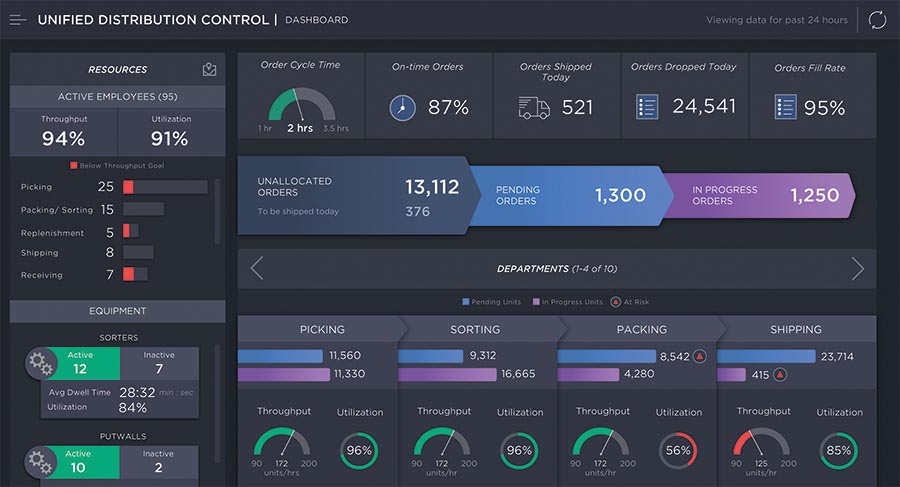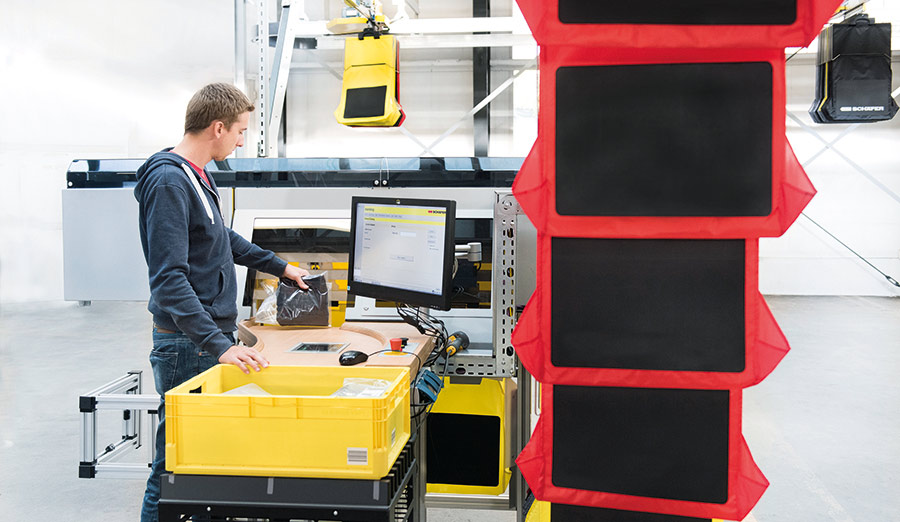E-commerce: Retailers flex to meet expectations
To address e-commerce and omni-channel challenges, many retailers are turning to automation, software and mobile computing solutions to find balance in their distribution channels.
It’s not breaking news that e-commerce has grown tremendously in the past few years, and shows no sign of slowing. Predictions from the National Retail Federation anticipate 2018’s overall retail sales to grow between 3.8% and 4.4% over 2017, with online sales—a part of that total percentage—rising by 10% to 12%. Further, the U.S. Census Bureau’s first quarter 2018 report found a 16.4% jump in retail e-commerce sales over first quarter 2017.
It’s also no revelation that as more consumers shop online and grow accustomed to the virtually endless selection of items offered by Amazon that they expect more selection from omni-channel retailers, regardless of the shopping format.
Woe to the retailer who doesn’t meet those expectations: Consider the numerous bankruptcies and shuttering of multiple storefronts, including Toys ‘R’ Us, Kmart, Foot Locker, Sears, J.C. Penney and more.
“All the growth in retail right now is on the direct-to-consumer side, and companies are finding e-commerce has grown a lot more than they thought it would a decade ago,” says Gary Cash, vice president of solution development at Pyramid, a part of Matthews Automation Solutions. “This has made it difficult for an operation trying to both replenish stores and fill e-commerce orders while using a single warehouse management system (WMS). In many cases, the software has not evolved to manage many different fulfillment processes.”
Due to their substantial order volume, large retailers with nationwide networks of stores and distribution centers can simply split fulfillment into separate facilities, with focused networks for store replenishment and direct-to-consumer fulfillment, says Cash. “Conversely, medium-sized retailers, who have smaller networks, tend to operate both e-commerce and store replenishment out of the same facility,” he continues. “This presents the challenge of balancing very different order flows and volumes in real time.”
Cash reports that a mix of automation and software solutions are increasingly being deployed to address those challenges. “We’re seeing more warehouse execution systems (WES) like ours being added to fill in the gaps of an existing WMS to achieve these types of single facility/multi-channel fulfillment goals,” he explains. “A WES enables a facility to become more flexible by adding functionality to build different types of picking waves and balancing workflows to fully use every area at all times.”

The latest developments in software are providing retailers with holistic inventory, labor management, facility capacity and equipment availability.
Further, the types of automation retailers are using are the ones that increase operational flexibility, Cash adds. “Put walls are relatively affordable and can be staffed as needed to handle fluctuations in volume, and autonomous mobile robots are gaining traction because of their independence in completing tasks while reducing seasonal staffing challenges,” he says.
“Additionally, automated finishing systems with bar code readers integrated to packing slip and label printers are being increasingly deployed to accommodate and verify compliance labeling and ensure accurate direct-to-consumer shipments, while minimizing the amount of labor required to complete these tasks,” says Cash.
Here is a look at some of the latest automation, software and mobile computing solutions being deployed by retailers as they seek balance among their different distribution channels.
Pocket sorter automation handles throughput of 1 million+ units per day
Thanks to the Amazon Effect, e-commerce and omni-channel retailers must dramatically expand their offerings to compete. That means significant growth in inventory, throughput, efficiency and flexibility.
According to Andy Williams, vice president of automation at Schaefer Systems International, today’s retail projects require the ability to store and access more than 1 million stock keeping units (SKUs), plus move them at daily rates of more than 1 million units with a 1-hour lead time.
“At this point, high throughput, perfect accuracy and on-time dispatch of many different item types across multiple shipping methods are just table stakes,” Williams notes. “And, retailers must provide this level of service in one of the tightest labor markets in modern history.”
Traditional solutions—such as ramping up a temporary workforce to boost discrete picking of items or batch picking to loop or line unit sorters—don’t scale efficiently or effectively enough to achieve the high number of picks and the required breadth of inventory support, he says.
“The most efficient way to move product inside a warehouse is in bulk, which is not possible in e-commerce/omni-channel environments. Instead, retailers must find the most effective way to dynamically singulate order flow to support picking at scale,” Williams says. “The best way is to efficiently and wavelessly singulate the flow from a high-density and high-throughput storage medium, such as pocket sortation backed by advanced order processing logic.”

Today’s retail DCs require the ability to store and access more than 1 million SKUs plus move them at daily rates of 1 million+ units with a 1-hour lead time. Pocket sorters can address those demands.
These overhead conveyance systems support rapidly changing order priorities using a series of automatic buffers and sequenced sortation to packing at a significantly reduced cost and facility footprint.
“Automated pocket sortation eliminates many of the inventory touches typically required,” he says. “Items go directly into pouches upon receipt and aren’t touched again until pack-out. Packing can even be done automatically.”
Each pocket is transported, buffered, singulated, sorted and sequenced according to the order priority dictated by the WES, allowing near real-time changes to be processed in the order pool. Williams adds that to meet 1-hour lead times, the WES continuously analyzes operational flow and data inputs from the WMS, warehouse control (WCS) and labor management systems (LMS).
Software enables complete inventory and omni-channel order management
The latest developments in software are providing retailers with holistic inventory, labor management, facility capacity and equipment availability, according to Manhattan Associates’ senior director of product management Eric Lamphier.
“As our customers look for solutions to help them increase the storage density of their growing number of SKUs, while touching the items less and processing orders faster than ever, they’re pulling in lots of different types of automation and robotic equipment while adjusting their processes,” Lamphier explains. “That’s why our new WMS includes an embedded WES that talks to all the equipment within an operation, regardless of the type or provider. The solution has insight into all of the automation, locations, inventory, labor and orders—regardless of fulfillment channel.”
The new WMS synchronizes all of those inputs into a comprehensive view of the distribution operation and overlays them with the characteristics of the orders at hand, Lamphier says. “Then, it prioritizes orders based on profile, relative urgency, ship dates, carrier pickup and cutoff times, and directs them to the optimal processing style. Simultaneously, the embedded WES determines how those orders can be most efficiently processed at that moment, based on availability of robots, people or a combination of the two.”
Manhattan also offers an omni-channel order management system that allows retailers to make every item across the network available at all times, regardless of whether it’s currently on the rack in a warehouse, in a truck in the yard or a shelf in the store. “This software accepts an order from any source—phone, laptop, call center and so on—then sends the order to the store in closest proximity to the customer based on enterprise priorities,” Lamphier explains.
Retailers also want this level of sophistication and inventory availability for demand and supply matching, adds Lamphier, noting that his company’s Active Inventory solution facilitates demand planning. “It continuously evaluates where product needs to be, predicting those locations based on demand forecasting and sophisticated mathematical models and algorithms. That allows retailers to ensure their inventory is properly allocated to align with today’s multi-channel, digitally transformed reality.”
Mobile computing devices optimize in-store experience
As omni-channel retailers work to ensure the optimal customer experience in-store and online, the functionality of mobile computing devices has evolved, says Karen Bomber, director of retail industry marketing at Honeywell Safety and Productivity Solutions.
“Today’s devices do much more than scan,” Bomber explains. “Particularly at the in-store level, associates now do much more than just stock shelves. That’s why our new CT40 mobile handheld computer uses an application called Connected Retail that guides associates through multiple workflows.”
Paired with a headset using Bluetooth, the device directs associates as they perform in-store replenishment tasks. It also guides in-store picking activities that support retailers’ increasing use of stores as fulfillment centers for “click-and-collect” customer purchases.
“The CT40 also facilitates item lookup, so associates can quickly determine if an item sought by a customer is somewhere in the store. It also connects to retailer-specific inventory management software and enables the associate to order the item from another store or fulfillment center for shipment to the customer’s preferred location on the spot,” Bomber says.
A ruggedized version of the device, the CT60, is engineered for use in distribution environments. “Both computers use our scalable Mobility Edge platform, a unified hardware architecture and set of software tools that streamline the deployment and management of these mobile devices,” she adds.
“Because it supports five versions of the Android operating system, it allows a retailer’s central IT department to develop and certify a software application one time before deploying it across enterprise mobile devices,” adds Bomber. “This saves time and costs associated with configuring and maintaining mobile computers across stores and warehouses.”
Companies mentioned in this article
- Honeywell Safety and Productivity Solutions
- Manhattan Associates
- Pyramid, a part of Matthews Automation Solutions
- Schaefer Systems International

Article Topics
Automation News & Resources
Beckhoff USA opens new office in Austin, Texas ASME Foundation wins grant for technical workforce development Walmart chooses Swisslog AS/RS and software for third milk processing facility Lucas Watson appointed CSO for Körber’s Parcel Logistics business in North America 60 Seconds with Bob Trebilcock, outgoing executive editor, Modern Materials Handling Kathleen Phelps to join FORTNA as chief financial officer Coles automates grocery distribution in Australia More AutomationLatest in Materials Handling
Beckhoff USA opens new office in Austin, Texas Manhattan Associates selects TeamViewer as partner for warehouse vision picking ASME Foundation wins grant for technical workforce development The (Not So) Secret Weapons: How Key Cabinets and Asset Management Lockers Are Changing Supply Chain Operations MODEX C-Suite Interview with Harold Vanasse: The perfect blend of automation and sustainability Consultant and industry leader John M. Hill passes on at age 86 Registration open for Pack Expo International 2024 More Materials HandlingAbout the Author
Subscribe to Materials Handling Magazine

Find out what the world's most innovative companies are doing to improve productivity in their plants and distribution centers.
Start your FREE subscription today.
April 2024 Modern Materials Handling

Latest Resources












